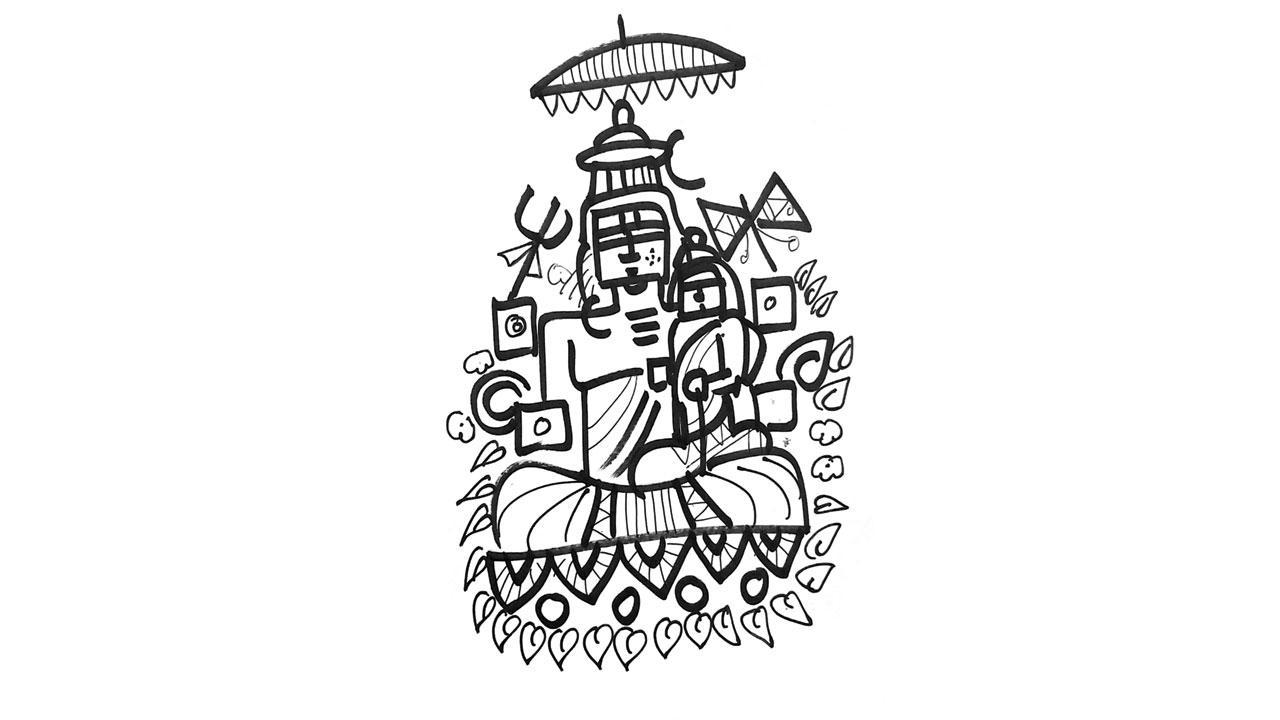And Hari, who was Vishnu, the shape-shifting householder, identified as bhagavan, the leader who apportions fairly to all in the group (sam-rajya)

Illustration/Devdutt Pattanaik
 Vedic prose and poetry is polytheistic. It refers to many gods, spelt without capitalization. Vedic philosophy starts considering the idea of one god. It seems monotheistic. But that is not quite true. Is this one god without (brahman) or within (atma) us? Is it infinite or finite, within the body (dehi) and in everything (ananta)? With form (saguna) or without form (nirguna)? Is it only the spiritual (purusha) or does it also include the material (purusha)?
Vedic prose and poetry is polytheistic. It refers to many gods, spelt without capitalization. Vedic philosophy starts considering the idea of one god. It seems monotheistic. But that is not quite true. Is this one god without (brahman) or within (atma) us? Is it infinite or finite, within the body (dehi) and in everything (ananta)? With form (saguna) or without form (nirguna)? Is it only the spiritual (purusha) or does it also include the material (purusha)?
Stories give two rather authoritative but complementary forms to this God, both male. Hara, who was Shiva, the still hermit, identified as ishwara, the sovereign master who establishes autonomy (sva-rajya). And Hari, who was Vishnu, the shape-shifting householder, identified as bhagavan, the leader who apportions fairly to all in the group (sam-rajya).
The two deities then become part of a male trinity: Brahma, who establishes the yagna; Shiva, who rejects the yagna; and Vishnu, who restores the yagna and becomes the yagna. Brahma is eventually replaced by the Goddess. She is the daughter who Brahma chases, not realising she is also his mother. She is the wife who domesticates Shiva. She is the responsibility as well as the guardian of Vishnu.
The introduction to this one god is made by a goddess in the Kena Upanishad, which was composed around 100 BC. The devas thought their victory was because of them. But a being appeared and challenged Agni, the fire-god to burn a straw. Agni failed. He then challenged Vayu, the wind-god to blow away that straw. Vayu failed too. Indra wondered who this being was. Beautiful Uma, daughter of the Himalayan mountains, introduced the mysterious being as the brahman.
Because Uma is introducing the brahman, he is identified as Uma’s husband, Shiva, who is traced to Rudra of the Vedic hymns. In Rig Veda, there are five hymns to Rudra, and many more in the Yajur Veda. He is visualized as a god of thunder and storms, a solitary figure of mountains and forests, who bears a bow and arrow, who has matted hair, who is unpredictable and aggressive, who is both malevolent and benevolent, capable of destruction and generation, who can heal as well as inflict disease, on cattle and children. He is father of the Marutta, the collective of wind-gods, who are referred to as the eleven Rudras. The hymns never talk of Rudra as the husband of Uma. There are only invocations but no stories.
In the Maitri Upanishad, composed around 300 AD, the concept of the three states of matter (tri-guna) is introduced and equated with three gods: Rajas (agitation) is equated with Brahma; Tamas (apathy) is equated with Shiva; Sattva (alertness) is equated with Vishnu.
Detailed stories of these new gods emerge much later, first as fragments within the Ramayana and the Mahabharata, around 100 AD, and then as a complete cycle in the purana, after 500 AD. Their images are carved on mountains, caves and temple walls. These new gods seem nothing like the gods described in Vedic verses. There was no Indra fighting Vritra, no escape of cows from Vala’s cave, no kindling of Agni, no rescue by Ashvins. Those who saw these images had never heard Vedic stories, experienced Vedic hymns, or participated in Vedic ceremonies. They were the chieftains of the South, East and West, potential patrons for the migrating Brahmins.
The author writes and lectures on the relevance of mythology in modern times. Reach him at devdutt.pattanaik@mid-day.com
 Subscribe today by clicking the link and stay updated with the latest news!" Click here!
Subscribe today by clicking the link and stay updated with the latest news!" Click here!










